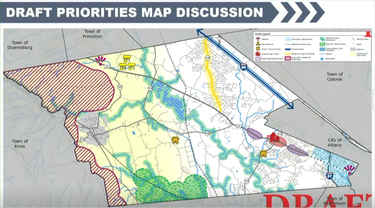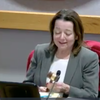First draft of Guilderland’s future presented, mapping priorities
GUILDERLAND — The Guilderland Comprehensive Plan Update Committee recently took a major step forward in its update of Guilderland’s two-decades-old land-use plan.
On May 14, project consultants from MJ Engineering provided the committee with an overview of the preliminary draft; the plan is to have the public comment in August or September.
“This is purposely a committee-only review draft,” said Consultant Jaclyn Hakes, “so that you as a committee, as the entity appointed by the town board to develop the draft plan, have the opportunity to review [it], make sure it reflects what you as a committee think that it needs to reflect, and prepare that for public review.”
Hakes explained that, rather than use a traditional land-use map, the town’s comprehensive plan would use a priorities map.
“We had been talking about a future land-use map, [but] as we got into this, we realized that didn’t really fit with what we were hearing in terms of major changes with future land uses, rather [it was] focusing on priorities and key locations in the community.”
The “themes” of the plan, Hakes said, include: agriculture; business; employment and fiscal resources; environment, climate change and resiliency; neighborhoods and housing; parks, recreation, open space, and historic resources; and transportation and mobility.
Hakes added that, within each of the themes, there is “some description of the connection to town character within each of those sections.”
She said town character was “something that came up early and often throughout the process as a priority.” But it was difficult to come up with a unified town character, Hakes said, “because Guilderland is many different things.”
But the consultants did attempt to connect town character within each of the sections, Hakes said, referring to the western part of town, for example, “talking about how those farm or rural viewsheds are part of the character of that part of Guilderland.”
With six thematic sections to go along with sections dedicated to the introduction, governance, and implementation, Hakes said each committee member was given two to three sections “to really focus closely on,” so they can “provide a more in-depth feedback.”
Committee member Richard Brustman said it looked like members were reviewing sections they’d created, which “to a certain extent that’s diminishing returns.”
Brustman said he was “just going to repeat things I said before,” but “on the other hand,” he hadn’t paid as close attention to other sections other committee members had worked on. “I would suggest why not randomize it,” he said.
James Abbruzzese, the committee’s vice chair, said the sections were distributed that way because “we wanted someone with the expertise of that particular committee [to] help guide the other guys, if there was questions .…” Hakes added that the approach had been used before, with great success.
At previous meetings, most of the feedback received concerned preserving existing areas or redeveloping already-developed ones, said MJ Engineering’s Jesse McCaughey; there was “not a lot of wholesale changes being recommended,” she said.
Priorities
A map created for the 20-plus-year-old comprehensive plan was shown to the board and now includes graphic representations of some of the current plan priorities.
Among the priorities represented were:
— Creating gateways at the Princetown border and in McKownville to enhance placemaking and sense of place;
— Protecting viewsheds in the Helderberg escarpment and Settles Hill area;
— Redeveloping sites along Western Avenue and incorporating streetscape enhancements in McKownville;
— Redeveloping existing sites, including brownfields, near the intersection of Foundry Road and Western Avenue (the proposed Foundry Square), and in Westmere;
— Potentially encouraging light commercial or mixed-use development near the town border with Princetown;
— Protecting the water quality of the Watervliet Reservoir through invasive species removal, water chestnut management, and preparedness plans for emerging contaminants;
— Protecting riparian corridors;
— Protecting the Black Creek Marsh overlay area for resiliency and flood management during heavy rainfalls;
— Improving access to and safety at Guilderland schools, particularly Farnsworth Middle School and the high school;
— Encouraging potential mixed-use and commercial development along Carman Road due to the presence of public transportation and infrastructure;
— Addressing capacity issues by diverting traffic from Route 20 to the Thruway;
— Continuing efforts to mitigate stormwater issues in McKownville (represented by light blue shading); and
— Potentially siting a town center at the intersection of Route 155 and Western Avenue, because it has the necessary transportation, water, and sewer infrastructure to support the concept.
Committee response
Committee members immediately sought clarification on a few of the priorities.
Elizabeth Lott, who is also chair of the town’s zoning board of appeals, asked why pedestrian improvements were limited to Rapp Road; couldn’t they be extended down Western Avenue to Route 155?
“So that's a great question. And that’s exactly the kind of input that we’re looking for,” Caughey said.
Hakes said, “What we're looking for is your kind of initial reaction, because we realized this is a shift in what we had been talking about with a potential future land-use map, it really just didn’t seem to make sense as we were starting to, as a team, sit down and brainstorm that.”
Steve Wilson wanted to discuss what he saw as too much simplicity in the way the plan was being presented. “In looking at the map, I'm struck, I realized that there’s a tension there, you want something that’s sort of a statement that can be looked at quickly and hit the high spots,” Wilson said, “but also I'm finding for the amount of work we put into this that it’s too general — I’ll put it that way; I’m trying to be kind.”
He also pointed out that one of the priorities might be difficult to implement. Along Carman Road, Wilson said, there is a call for mixed-use, “but my memory on driving [on Route] 146 is [there’s] extensive residential abutting the road, and that extends back up [to] the various lanes.”
Hakes said that too much detail could cause the map to become “crowded and you can’t read anything. So just graphically, right? I mean, if we had this on a 22 [inch] by 36 [inch] board, that would be a little different, but that’s not going to be accessible to everybody.”
There were then suggestions made to zoom in on key areas or to split the map into quadrants.
Hakes said she’d like the committee’s feedback by July 11, so changes can be made for its July 24 meeting, with a public meeting on the proposed draft plan to follow in August or September.



